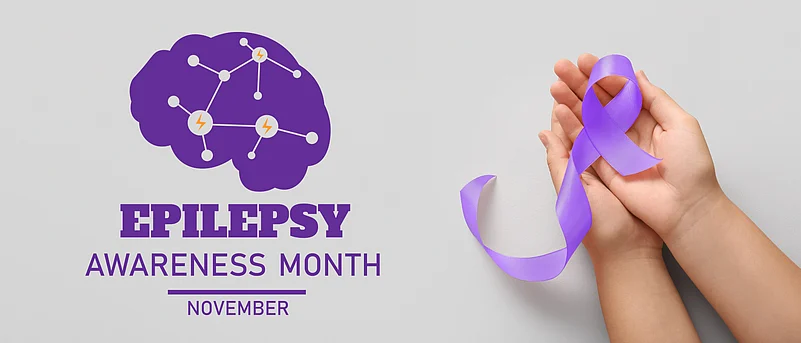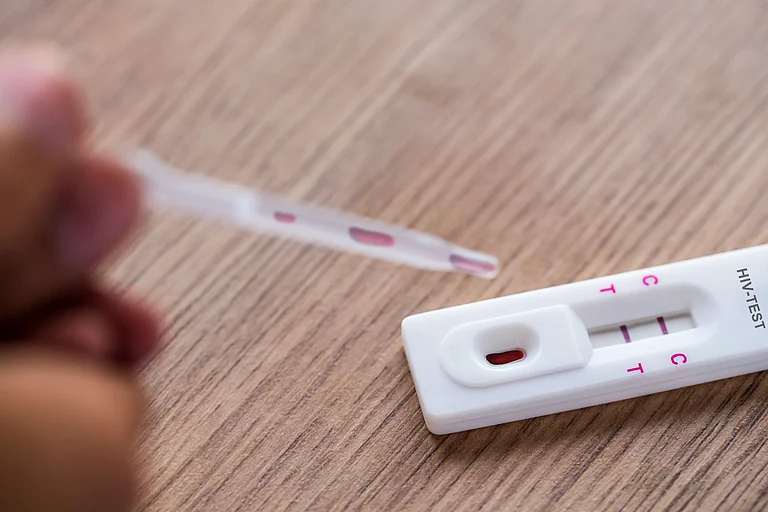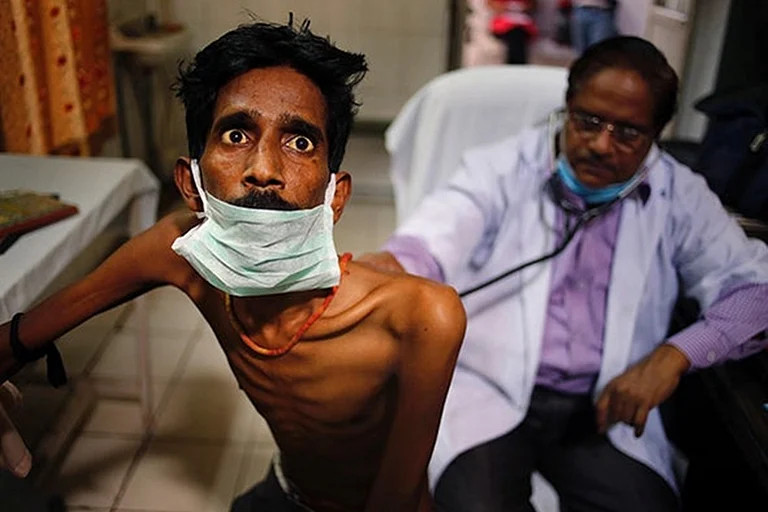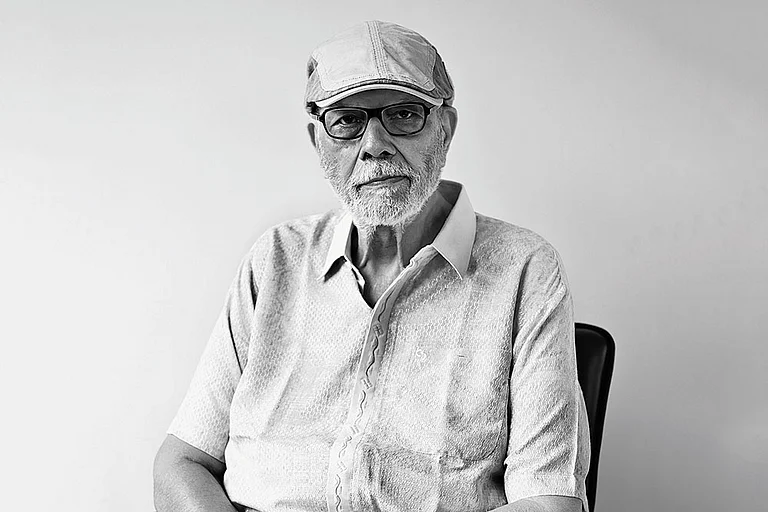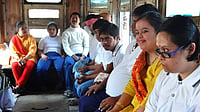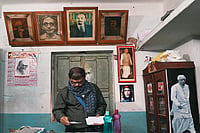
According to the WHO, 1 in every 100 people faints at least once in their lifetime, and 1 in every 200 individuals has epilepsy
India accounts for nearly one-sixth of the global epilepsy burden
A Public Interest Litigation (PIL) filed in the courts seeks to include epilepsy within the scope of health and life insurance coverage
When Pooja Mehta Nandi collapsed at her workplace in Mumbai many years ago, the first thing she smelled after regaining consciousness was an onion someone had held under her nose. A metal key had been shoved into her mouth; someone else handed her a bottle of Mangola, exactly what she shouldn’t have been given. The room had filled with panic, confusion, and well-meaning but harmful gestures.
That incident, which a former media professional-turned-entrepreneur, Nandi, recalls, was the day she realised how little people know about seizures and how deeply misunderstood epilepsy remains in India. Today, as a neurodiversity advocate and treasurer of Samman, the Mumbai chapter of the Indian Epilepsy Association, she uses that memory as a reminder of the work still to be done.
According to the WHO, 1 in every 100 people faints at least once in their lifetime, and 1 in every 200 individuals has epilepsy. Every November, during Epilepsy Awareness Month, the conversation picks up. “Epilepsy is a chronic condition, and managing it effectively depends on awareness and treatment adherence. We all know what to do if someone has a heart attack on the road. Yet, we still lack clarity on how to assist someone who faints,” says Nandi.
Understanding a Misunderstood Condition
Despite being one of the world’s oldest known neurological disorders, epilepsy remains entangled in superstition, fear, stigma and silence.
Breaking it down for a layman, Dr Manjari Tripathi, head of the department of neurology at AIIMS Delhi, explains, “Epilepsy is not a mental disease. It is not a supernatural disease. It is not caused by bad karma from a past birth. It is a medical condition caused by dysfunctional neurons that are hyperexcitable.” And these neurons can become hyperexcited at any age.
Nandi and others, including a trained psychologist and a commercial artist and the founder of the NGO Sanvedana Foundation, Yashoda Wakankar in Pune; calligraphy maestro, professor of penmanship and management, and founder of J’s Quill Group Prof. K.C. Janardhan in Bengaluru; and a practising lawyer in the High Court and Supreme Court in New Delhi Gurbani Kaur Bhatia, were diagnosed early in their childhood. Meanwhile, super randonneur, ultra-cyclist, marathoner, and motivational speaker Vinay Jani was diagnosed with this disorder much later, in his adulthood.
Nandi, Bhatia, Wakankar, Janardhan, and Jani come from diverse backgrounds, work in various professions across different generations, and reside in different parts of the country. Yet, what unites them is the fact that they are all persons with epilepsy (PWE) who refuse to be defined by it. Each of them proves that life beyond seizures is not only possible but also full of purpose, passion, and promise.
Living beyond seizures
The straightforward facts rarely reach homes, schools, or workplaces. Instead, symptoms are often dismissed or misinterpreted. People who faint are thought to be exhausted or weak. Convulsions inspire fear and panic. Families hide diagnoses. Communities rely on folk remedies. Misconceptions spread.
Living with seizures is never easy, and it wasn’t any easier for them as children or adults to understand what was happening to their bodies, adapt to medication and treatment, and make lifestyle changes to lead a normal life.
Jani, based in New Delhi, who is a Golden Light Awardee of the International Bureau for Epilepsy (IBE) for his work in epilepsy awareness, recalls having a limited understanding of the condition and navigating through uncertainty and fear. The medication helped initially, but then it stopped. By late 2020, his epilepsy had become drug-resistant. “After multiple trials with different medications and experiencing their side effects, I ultimately underwent neurosurgery, a life-changing decision that has since given me a seizure-free life,” he adds. He is happily married and has a 9-year-old daughter.
Wakankar also had surgery, while Nandi, Bhatia, and Janardhan have managed their condition with medications and are now seizure-free. Janardhan was diagnosed with Hot Water Epilepsy in the early 1960s, which was misunderstood as a prank or possession due to a lack of awareness. “Dr. K.S. Mani’s diagnosis at age 8 made me realise that society favours performers over underdogs. To fight stigma, I focused on showcasing my talents in painting, sculpting, mimicry, and mono acting,” Janardhan recounts. Today, he is open about his condition to raise awareness and advocates against stigma through his personal achievements.
Dr Tripathi explains that epilepsy is mainly misunderstood because the community has limited knowledge of its causes and solutions. “This, in turn, creates a vicious cycle where treatment-seeking behaviour diminishes due to stigma attached to the disease, causing many with epilepsy to drop out of treatment—creating a secondary treatment gap, and also do not seek treatment, causing a primary treatment gap.”
Support building exercise
Having said that, she concurs that the journey for someone with epilepsy is not easy and involves physical, emotional, and social challenges. “From managing the unpredictability of seizures to facing stigma and self-doubt, every stage tests patience and resilience. Yet, it also gives me and others a sense of purpose—to advocate for those who feel alone on this journey,” Jani adds.
Wakankar was seven when her neurological condition was diagnosed. “My parents knew the challenges ahead and encouraged me to handle the seizures with confidence. I used to have 10-12 seizures a month. But they advised me to see everything positively, despite these challenges, and to overcome them,” she shares.
Nandi emphasises the importance of support group meetings for both people with epilepsy and their caregivers, as they help individuals learn more about the condition, share experiences, and, most importantly, realise they are not alone. “Interacting with others who face similar challenges helps reduce fear, stigma, and insecurity, replacing them with confidence and a sense of community. Over time, support groups create a safe space to talk openly, ask questions, and live more comfortably with epilepsy,” Nandi states.
Wakankar recalls how the first call for such a meeting in Pune in 2004 received a strong response, mainly through word of mouth. “People came with many stories and left feeling reassured that they are not alone. The Epilepsy Support Group Meetings provide a safe space for connection, understanding, and mutual healing,” she adds, as the founder of Sanvedana Foundation. Her NGO has organised over 1,000 such meetings, with a network of more than 5,000 individuals.
Bhatia’s family responded with love and acceptance, treating epilepsy as a health condition rather than a limitation. “It was confusing and overwhelming at first, not only because of the diagnosis but also because there is so little discussion about epilepsy in our schools and communities. However, I was lucky to have strong family support throughout,” she shares, as a young lawyer from Delhi.
The support, acceptance, and encouragement from her family helped her rebuild confidence and find strength during difficult times. Awareness and understanding at the workplace and among colleagues also help reduce fear and hesitation. Jani highlights the motivation he received from his cycling and running communities. “Their inclusion and belief in me played a crucial role in my recovery and returning to an active lifestyle after surgery,” he concludes.
Treatment: A Complex Landscape
Managing epilepsy requires a combination of correct diagnosis, regular medication, and consistent monitoring. However, in India, each of these steps is hindered by barriers—structural, financial, and social. There are 20 anti-seizure medicines, but only 8 are available at subsidised rates, and just a few are included in the national “essential” list. Dr Tripathi says that these eight anti-seizure medicines are enough to control 70 per cent of the seizures. These medicines are not randomly chosen, but are part of the 'essential drug list', a list of medications considered necessary and cost-effective for a basic healthcare system.
Based on her experiences, Dr Tripathi says that quite often, the cause of the treatment gap is that the free medication is given only for a few days or a month, while epilepsy treatment continues for years. “Patients are given long enough medication in terms of months and months of therapy, and are urged to come back for replacement as soon as they know two weeks of the medication must be left with them,” she adds. However, she adds that “the emphasis should be on ensuring that all eight medicines are available at each healthcare setup. Currently, they are not available at all healthcare setups, such as primary health centres, wellness centres, district hospitals, government hospitals, medical colleges, as well as tertiary centres, although they are included in the essential drug list.”
She also busts the myth that an EEG contributes to the diagnosis and that a video EEG is essential to the diagnosis of epilepsy. “A detailed history and home videos showing the seizures obtained on the mobile phones are good for a clinical history. These can be provided by an eyewitness, and a home video recording is often sufficient to make a clinical diagnosis. We can supplement it with the EEG, but the EEG cannot confirm the diagnosis,” Dr Tripathi clarifies.
The costs of regular consultations, diagnostic tests such as EEG and MRI, and long-term medication can add up significantly. “Access to neurologists, medication, and diagnostics remains uneven, particularly outside cities. The cost and availability of consistent treatment remain big hurdles for most PWEs,” says Bhatia.
In drug-resistant cases like Jani’s, the cost of surgery and pre-surgical evaluations is even higher. This economic burden was one of the reasons he advocates for improved access to affordable epilepsy care. “Through fundraising and awareness runs, I try to support NGOs that provide medicines to underprivileged PWEs because no one should have to choose between treatment and survival,” says Jani.
Bhatia couldn’t agree more with Jani and says that a packet of 100 mg of anti-seizure medicine costs anywhere between Rs 350-400 for 10 tablets, which lasts about five days based on the doctor’s prescribed dosage. “Over time, this adds up, especially with regular check-ups and tests. I’m deeply privileged to have caregivers who have ensured that I never feel like a financial burden, but I am acutely aware that for many families, the cost of consistent treatment can be prohibitive,” says the lawyer.
Helping those in need with medicines and covering their surgical costs is one of the most important activities undertaken by the Sanvedana Foundation. “Epilepsy is such a disorder that people have to be on medication for years and years. However, unfortunately, in India, many people are not able to spend money on their epilepsy medications. We started doing it free of cost. We feel proud to share that currently we are helping 210 people with their epilepsy medications,” says Wakankar. Her NGO not only assists with epilepsy medications but also helps with tests such as EEG, MRI, and CT Scans, among others, and has initiated supporting brain surgeries with Bajaj FinServ’s CSR fund.
Understanding the challenges
For the first time, India is aligning its epilepsy policies with the WHO’s Intersectoral Global Action Plan on epilepsy and other neurological disorders (IGAP) within its policy framework, which includes epilepsy as a key neurological condition. This aligns with the WHO’s call for governments worldwide to adopt and achieve specific targets for better epilepsy care and awareness.
However, experts say the implementation remains inconsistent. Access to affordable treatment, public awareness, early diagnosis, and workplace inclusion for PWEs still fall short of global standards. These challenges form the core of India’s epilepsy story in 2025, a narrative not just about seizures but about the right to live, work, drive, and thrive with dignity. Understanding these challenges is crucial to advocating for change and improving the lives of those with epilepsy.
In rural India, where infrastructure is poor, even basic neurological care remains a privilege. Dr Bindu Menon, a neurologist and founder of the Dr Bindu Menon Foundation, Secretary General of the Indian Epilepsy Association, and Board Member of the World Stroke Organisation, has been working in remote hamlets in and around Nellore, Andhra Pradesh, for decades. Dr Menon has been operating a flagship project called "Neurology on Wheels" for 20 years, travelling to rural areas in and around Nellore in a specially designed clinic bus, and has reached 59 villages so far. “Neurology on Wheels takes neurology care from urban to rural India. We reach remote villages, create awareness about stroke and epilepsy, screen people for hypertension and diabetes, and provide free medications for up to a month.” This is an important cog in epilepsy care because, based on her experience, she feels that “there’s a striking gap between the urban and rural in terms of secondary prevention. Patients often start their medication but fail to follow up, leading to relapses that could easily be prevented.”
Samman has been actively conducting school and office awareness programmes. “We have been participating in the Tata Mumbai Marathon for the last 10 years, we have started an Epilepsy Awareness Marathon since the last two years, and we have been conducting rural clinics for the last 25 years in different locations and many more initiatives to spread understanding,” says Nandi.
Dr Menon has been working on paediatric epilepsy and awareness about this condition among schoolchildren, teaching and non-teaching staff. “Through our foundation, we’ve conducted over 250 awareness programs, including 105 in schools. We engage teachers, students, and staff, using comics and skits to explain what to do and what not to do when someone has a seizure,” says, adding that “teachers are community heroes. When they talk about epilepsy with knowledge and dignity, it changes how the entire village views the condition.”
In an attempt to demystify and destigmatise epilepsy, Samman Association conducted an online teacher education programme led by top neurologists from June to October 2021, reaching 7,200 teachers working for Brihanmumbai Municipal Corporation schools. Each one-hour session included a PowerPoint presentation on epilepsy basics, first aid, and stigma, followed by Q&A and discussion. The program, led by neurologists and committee members including Dr Pravina Shah, Dr Pradnya Gadgil, Dr Jayanti Mani, and others, significantly improved teachers’ understanding and response to epilepsy. “Before the training, 43 per cent of teachers believed in ineffective first-aid myths (like using onions or slippers during seizures), which dropped to 13 per cent post-training. Afterwards, 93 per cent felt confident recognising seizures, explaining epilepsy, promoting inclusion in regular schools, and handling emergencies,” says Nandi.
In November 2020, Samman also partnered with IIT Techfest, Mumbai, to conduct a nationwide epilepsy education drive involving 40 neurologists and reaching 1,000 students and teachers. To further spread awareness, Samman created a 5-minute animated film, “Jiyo Samman Se” (Live with Respect), available in English, Hindi, and Marathi.
Another significant shift is the increased use of technology and social media, which has made accessing information easier for PWEs and their caregivers. “All these combined efforts are making a positive difference. More people are opening up, learning, and talking about epilepsy. But it’s still a drop in the ocean, and we have a long way to go before awareness becomes universal,” says Nandi.
The gendered impact of epilepsy
The impact of epilepsy is gendered, with women bearing more of the burden when it comes to acceptance. Based on her medical interactions, Dr. Tripathi adds that many women with epilepsy find it difficult to get married. If they do marry, they often struggle to keep the marriage because the husband's family may not understand and might even evict them from the house. “Almost 80 to 90 percent of marriages end in divorce. Women with epilepsy must focus on education, financial independence, and only then consider marriage and settling down,” she says matter-of-factly.
Stigma often causes people to hide their neurological condition, especially when seeking a partner. Besides other activities, her foundation also operates an Epilepsy Marriage Bureau, and to date, Wakankar has successfully matched 30-plus couples. Wakankar, who eventually married the man who accepted her health condition with love and care, adds that “one needs to be confident and open about the condition; then, people will accept you, and you can survive. This mindset has helped me a lot because I always speak openly about my epilepsy."
Nandi, who in her role at Samman champions the cause of empowering PWEs and works to eliminate stigma through education and advocacy, couldn’t agree more. Nandi says women with controlled epilepsy can lead a healthy, normal married life like any other woman and can also have children. “It is best for the family to be honest and tell the groom's side about this rather than hide it. The couple should discuss it first, meet the doctor, understand the situation, and then involve the families. This is my personal opinion,” she clarifies.
In an arranged marriage set-up, it might appear somewhat challenging; therefore, Nandi emphasises that more than marriage, it is crucial to educate the girl child and enable her to live an independent life with epilepsy. This will also boost her confidence to engage in necessary conversations about her neurological condition.
Driving, insurance, and the fight for rights
Two parallel advocacy movements are gathering momentum in India: insurance and driving licences for PWEs. The Indian Epilepsy Association and Sanvedana Foundation are working on two major advocacy fronts—access to insurance and the right to drive for PWEs.
A Public Interest Litigation (PIL) filed in the courts seeks to include epilepsy within the scope of health and life insurance coverage. If successful, this could challenge long-standing industry biases that categorise epilepsy as an automatic exclusion, encouraging insurers and policymakers to see it as a manageable neurological condition rather than a “risk.” Those who are covered under health insurance pay a hefty premium. “No one should have to pay a higher insurance premium because they have epilepsy. This is discrimination that needs to end,” says Dr Menon.
She adds that “at present, people simply don’t disclose epilepsy when applying for a driving license. That’s unsafe. We should create a system that encourages disclosure and ensures road safety.” Another issue currently under discussion in advocacy work is whether individuals with controlled epilepsy can legally drive. The government is reviewing regulations that could define, assess, and certify medical fitness. This move could significantly impact the daily lives of thousands of people. “People with well-controlled epilepsy, who have been seizure-free for three years on stable medication, should be allowed to drive. Countries like the US, Australia, Germany, and Japan already permit this under regulated frameworks. India can too,” says Dr Menon.
The discrimination in availing an insurance or seeking a driving licence for those who have been seizure-free is a nagging issue for Jani and many others, who are advocating evidence-based changes in these rules so that people who are medically fit are not unfairly deprived of their right to drive. “We have been discussing these issues for so many years without making progress, as governments and policymakers have only a superficial understanding of these matters. Most developed countries have these practices in place, yet we have failed to implement necessary policy changes and put them into action,” advocates Janardhan.
Bhatia suggests policies that promote inclusion, acceptance and understanding, rather than silence and avoidance. “The focus should be on explicitly including epilepsy in anti-discrimination frameworks and ensuring those protections are enforced. Awareness campaigns alongside legal clarity can shift public perception from fear to understanding,” she suggests.
A Way Forward: What India Needs Now
India accounts for nearly one-sixth of the global epilepsy burden. “The World Health Organisation once said no person with epilepsy should go without medication, even an inexpensive drug like phenobarbital can control seizures effectively,” highlights Dr Menon, adding that “if primary healthcare physicians are trained to recognise seizures and dispense essential drugs, we can drastically reduce the epilepsy treatment gap.”
While Dr Tripathi highlighted the epilepsy treatment gap, Dr Menon paints a dismal picture in rural India and says, “In rural areas, the treatment gap can be as high as 80 per cent. It is not just medical; it’s social, economic, and systemic. Stigma, lack of resources, and sheer inaccessibility keep patients away from healthcare.” While her foundation has completed over 250 free medical camps, these examples are few and far between. According to her, integrating epilepsy care into the National Health Missions is the most viable option because epilepsy care can align beautifully with ongoing missions on mental health and non-communicable diseases. “We don’t need another vertical program for epilepsy. Instead, we should integrate epilepsy care into existing structures, such as the National Health Mission or the NCD program. The government system is already burdened, so let’s work within it.”
Taking a bottom-up approach, Janardhan suggests training teachers, caregivers, and community health workers to identify and support individuals with epilepsy, while encouraging patients and their families to share feedback on access to treatment. These insights will then be used to shape national policies and healthcare programs. He strongly advocates empowering the base and letting solutions emerge from the ground up. Janardhan says, “The government should run more awareness campaigns focused on inclusivity and equal opportunities for PWEs to lead a dignified life by improving their social status and quality of life, mapping their progress and maintaining a registry for wider understanding.” He suggests that the government could consider initiating programs to provide affordable treatment, affordable insurance schemes, and free insurance coverage for individuals under BPL schemes for PWEs.
Among the many policy and systemic recommendations, Dr Menon suggests, “Affordable medications and uninterrupted drug supply chains are non-negotiable. No one should have to walk miles for a pill. If every Primary Health Centre maintains essential anti-seizure medicines, and healthcare providers are trained to recognise and treat epilepsy, we can close the treatment gap meaningfully.” According to her, “tele-neurology can be a game-changer. The government already uses telemedicine effectively. Neurology should be the next frontier.”
Echoing the sentiments of PWEs, Nandi has a simple message, Let’s talk about epilepsy. “Epilepsy is not a limitation with the right treatment, awareness, and acceptance; PWEs can live full, successful, and happy lives. So this month, let’s promise to learn, share, and speak up, because awareness saves lives and together, we can make a difference,” she emphasises.
While Dr Tripathi agrees that the community must empathise with persons with epilepsy and support them, what works best is the ‘I can do it’ attitude for PWEs. “Caregivers of PWEs play a crucial role in this process. They need to realise that people have rallied and advocated for diseases that are 20 or 30 times worse than epilepsy. Their collective advocacy has led to shifts in management policies, not just at the government level but also at the individual and community levels.” This kind of rallying and advocacy by patients and their caregivers should be encouraged, and success stories of PWEs can serve as a powerful source of inspiration, she adds.
For Jani, Nandi, Bhatia, Wakankar and Janardhan, and millions of Indians, epilepsy is not a barrier but a battle one fought with medication, support, resilience, and hope. “PWEs can live full, successful, happy lives,” Nandi says. “We just need understanding, inclusion, and acceptance.”






